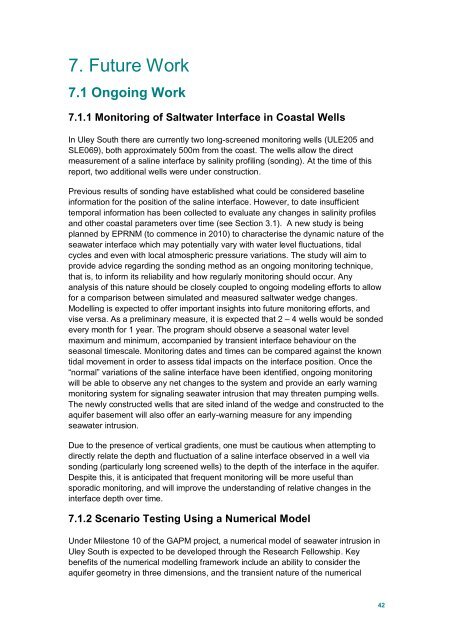Saltwater intrusion in Southern Eyre Peninsula, December 2009
Saltwater intrusion in Southern Eyre Peninsula, December 2009
Saltwater intrusion in Southern Eyre Peninsula, December 2009
You also want an ePaper? Increase the reach of your titles
YUMPU automatically turns print PDFs into web optimized ePapers that Google loves.
7. Future Work<br />
7.1 Ongo<strong>in</strong>g Work<br />
7.1.1 Monitor<strong>in</strong>g of <strong>Saltwater</strong> Interface <strong>in</strong> Coastal Wells<br />
In Uley South there are currently two long-screened monitor<strong>in</strong>g wells (ULE205 and<br />
SLE069), both approximately 500m from the coast. The wells allow the direct<br />
measurement of a sal<strong>in</strong>e <strong>in</strong>terface by sal<strong>in</strong>ity profil<strong>in</strong>g (sond<strong>in</strong>g). At the time of this<br />
report, two additional wells were under construction.<br />
Previous results of sond<strong>in</strong>g have established what could be considered basel<strong>in</strong>e<br />
<strong>in</strong>formation for the position of the sal<strong>in</strong>e <strong>in</strong>terface. However, to date <strong>in</strong>sufficient<br />
temporal <strong>in</strong>formation has been collected to evaluate any changes <strong>in</strong> sal<strong>in</strong>ity profiles<br />
and other coastal parameters over time (see Section 3.1). A new study is be<strong>in</strong>g<br />
planned by EPRNM (to commence <strong>in</strong> 2010) to characterise the dynamic nature of the<br />
seawater <strong>in</strong>terface which may potentially vary with water level fluctuations, tidal<br />
cycles and even with local atmospheric pressure variations. The study will aim to<br />
provide advice regard<strong>in</strong>g the sond<strong>in</strong>g method as an ongo<strong>in</strong>g monitor<strong>in</strong>g technique,<br />
that is, to <strong>in</strong>form its reliability and how regularly monitor<strong>in</strong>g should occur. Any<br />
analysis of this nature should be closely coupled to ongo<strong>in</strong>g model<strong>in</strong>g efforts to allow<br />
for a comparison between simulated and measured saltwater wedge changes.<br />
Modell<strong>in</strong>g is expected to offer important <strong>in</strong>sights <strong>in</strong>to future monitor<strong>in</strong>g efforts, and<br />
vise versa. As a prelim<strong>in</strong>ary measure, it is expected that 2 – 4 wells would be sonded<br />
every month for 1 year. The program should observe a seasonal water level<br />
maximum and m<strong>in</strong>imum, accompanied by transient <strong>in</strong>terface behaviour on the<br />
seasonal timescale. Monitor<strong>in</strong>g dates and times can be compared aga<strong>in</strong>st the known<br />
tidal movement <strong>in</strong> order to assess tidal impacts on the <strong>in</strong>terface position. Once the<br />
“normal” variations of the sal<strong>in</strong>e <strong>in</strong>terface have been identified, ongo<strong>in</strong>g monitor<strong>in</strong>g<br />
will be able to observe any net changes to the system and provide an early warn<strong>in</strong>g<br />
monitor<strong>in</strong>g system for signal<strong>in</strong>g seawater <strong><strong>in</strong>trusion</strong> that may threaten pump<strong>in</strong>g wells.<br />
The newly constructed wells that are sited <strong>in</strong>land of the wedge and constructed to the<br />
aquifer basement will also offer an early-warn<strong>in</strong>g measure for any impend<strong>in</strong>g<br />
seawater <strong><strong>in</strong>trusion</strong>.<br />
Due to the presence of vertical gradients, one must be cautious when attempt<strong>in</strong>g to<br />
directly relate the depth and fluctuation of a sal<strong>in</strong>e <strong>in</strong>terface observed <strong>in</strong> a well via<br />
sond<strong>in</strong>g (particularly long screened wells) to the depth of the <strong>in</strong>terface <strong>in</strong> the aquifer.<br />
Despite this, it is anticipated that frequent monitor<strong>in</strong>g will be more useful than<br />
sporadic monitor<strong>in</strong>g, and will improve the understand<strong>in</strong>g of relative changes <strong>in</strong> the<br />
<strong>in</strong>terface depth over time.<br />
7.1.2 Scenario Test<strong>in</strong>g Us<strong>in</strong>g a Numerical Model<br />
Under Milestone 10 of the GAPM project, a numerical model of seawater <strong><strong>in</strong>trusion</strong> <strong>in</strong><br />
Uley South is expected to be developed through the Research Fellowship. Key<br />
benefits of the numerical modell<strong>in</strong>g framework <strong>in</strong>clude an ability to consider the<br />
aquifer geometry <strong>in</strong> three dimensions, and the transient nature of the numerical<br />
42

















